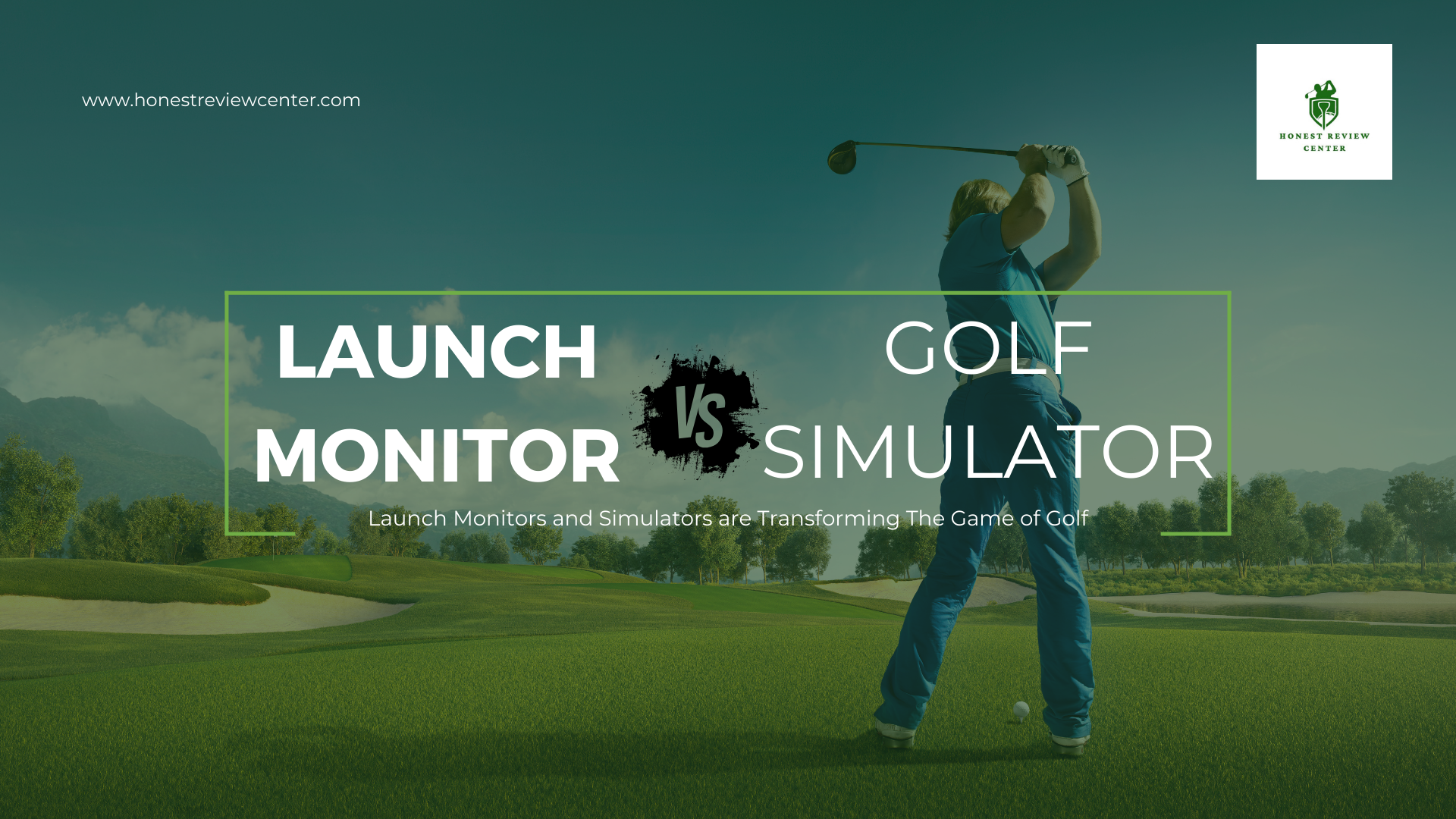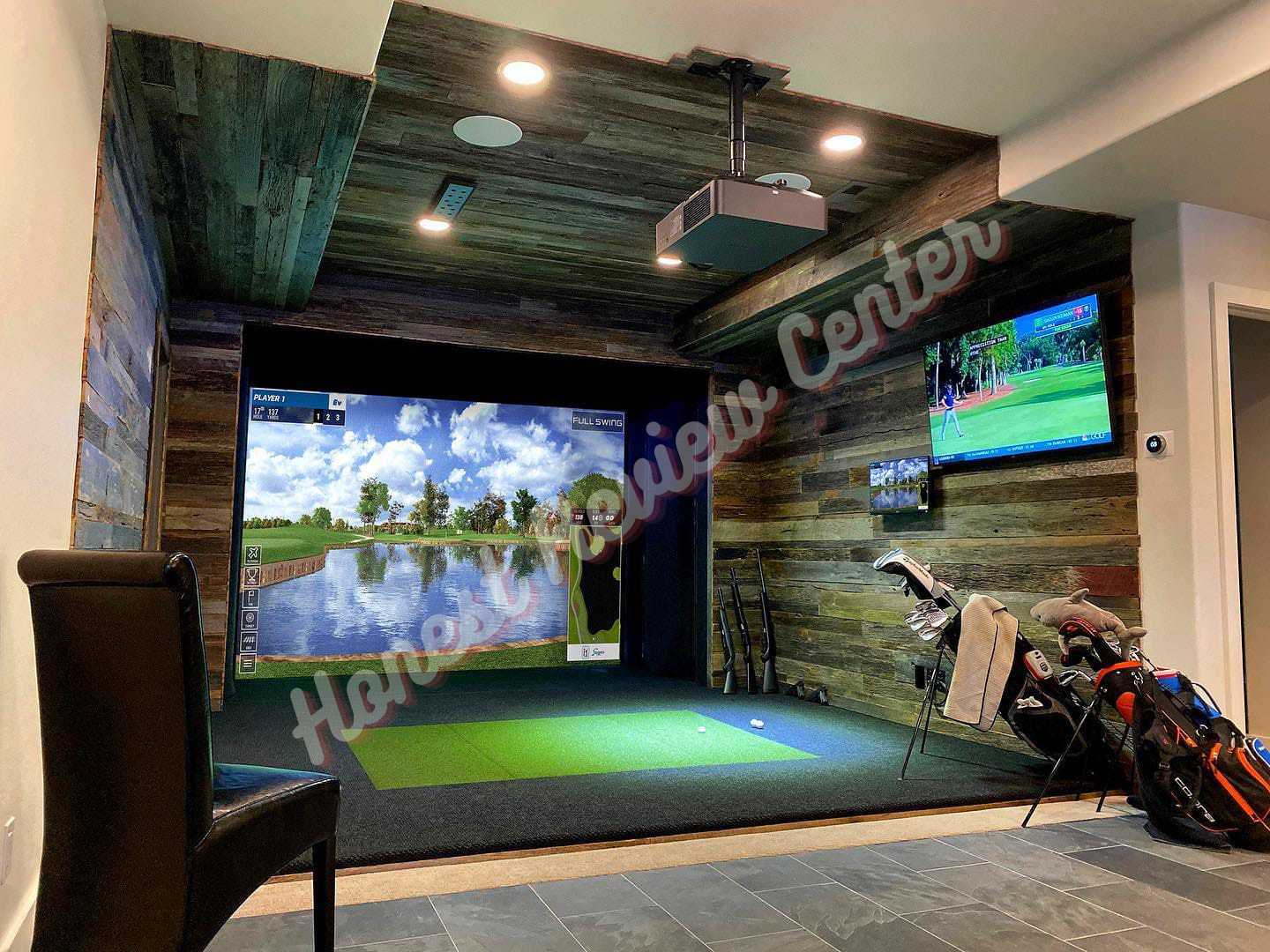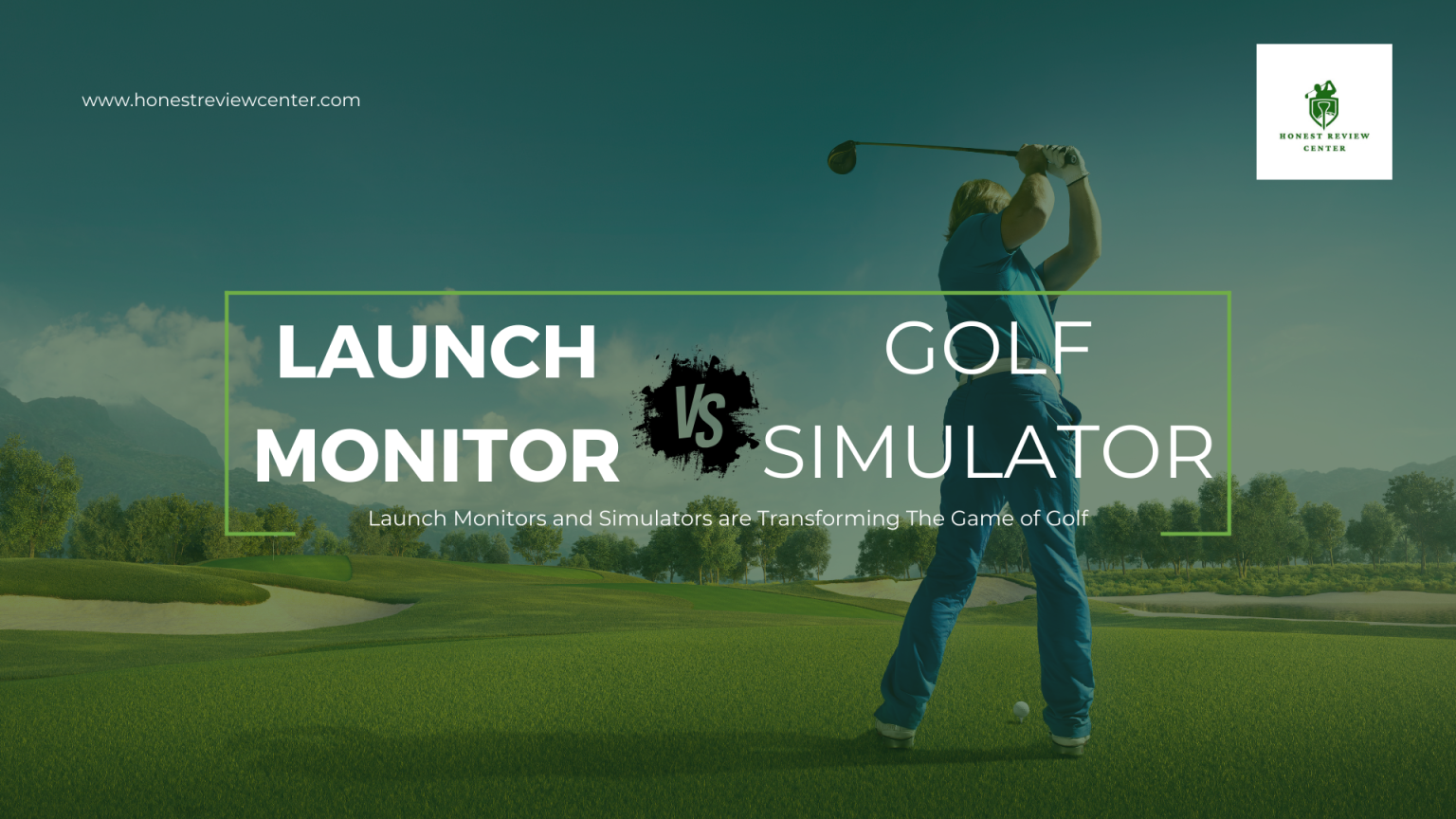Golfers looking to improve their game now have more options than ever with the help of advanced technology. Golf launch monitors and golf simulators are two of the most popular solutions for golfers who want to examine and enhance their swing. Today we are explaining the difference between golf launch monitor vs golf simulator, compare launch monitors and simulators, their features and capabilities, pricing considerations, and how to choose which is the better investment for improving your golf game.
Golf technology has progressed significantly during the last decade. With so many alternatives available today, it can be tough to comprehend the fundamental distinctions and decide which is ideal for your needs.
Launch Monitors and Simulators are Transforming The Game of Golf

What is a Golf Launch Monitor?
A launch monitor is a compact, portable gadget that sits behind the player to assess each stroke. Launch monitors use radar or camera technology to track crucial statistics such as clubhead speed, ball speed, launch angle, spin rate, carry distance, and total distance. This data enables golfers to better understand their swing mechanics and optimize their equipment.
Launch monitors are most typically used to optimize launch conditions on driving ranges or during practice sessions. Golfers who understand their swing data can make adjustments to maximize distance and control.
Top companies such as TrackMan and FlightScope dominate the launch monitor industry. Newer, less expensive solutions such as SkyTrak and Mevo provide useful swing statistics.
Understanding Launch Monitors:
Launch monitors are small gadgets that track precise data about your golf swing and ball path. They use Doppler radar, high-speed cameras, and sensors to assess important swing and ball parameters such as clubhead speed, ball speed, launch angle, backspin, side spin, carry distance, total distance, and more.
Here are some of the main reasons serious golfers utilize launch monitors:
1) Practice More Efficiently: Receive immediate feedback without waiting for results, allowing you to concentrate on fixes right away while the feel is new.
2) Track Progress Over Time: Save swing data from practice sessions to track progress and compare before and after equipment adjustments.
3) Analyze Swing Mechanics: The detailed data identifies your swing’s strengths and weaknesses, allowing you to improve technique, consistency, and maximize launch conditions.
4) Dial in Equipment: Learn how parameters such as loft, shaft flex, and ball type affect shot shape, distance, and spin to fine-tune your setup.
5) Compete Virtually: Some launch monitors provide simulation capabilities, allowing you to play virtual rounds and compare your shot data to other golfers.
Top Launch Monitor Brands

Check Latest Launch Monitors on Amazon
The launch monitor market has developed dramatically in response to technological developments and golfers’ desire to examine their swing. Here are some of the main options that golfers use:
- TrackMan is the leader in professional events and elite facilities. provides the most extensive data modeling and analysis. Portable and high-end underground systems.
- FlightScope is also widely utilized on professional tours, with a concentration on 3D Doppler radar ball flight tracking. Data is accurate and of TOUR quality.
- Mevo+ – An entry-level launch monitor priced at $499. The analytics are limited, but they do record shot distances and basic swing data.
- SkyTrak offers affordable personal launch monitors starting at $1995. Measure all important club and ball data. Popular with serious amateurs.
- Voice Caddie – Low-cost variants SC100 and SC200+ starting at $350. Good functionality for new users.
Launch Monitor Features:
With the large range of launch monitors now available, it is important to understand the fundamental elements that allow them to effectively track and analyze your swing.
1) Detection Technology: Most employ radar or high-speed cameras to monitor your club and the ball right after impact.
2) Realistic Ball Flight Simulation: High-end monitors employ extensive modeling to create a realistic image of each shot’s flight.
3) Swing Analysis: Specific swing parameters including as attack angle, dynamic loft, and shaft lean aid in identifying swing problems.
4) Carry Distance Calculation: Using ball flight characteristics, algorithms estimate the carry distance for your unique shot.
5) Total Distance Calculation: The monitor uses factors such as ball speed and spin rate to compute the anticipated total yardage for each shot.
6) club/ball tracking: Advanced sensors collect 3D information such as clubhead speed, clubface angle, ball speed, and launch angle.
7) Data Display and Evaluation: Mobile and tablet connectivity enables quick data evaluation and analysis following shots.
8) Portability: Most choose compact, lightweight versions for use outdoors and on the range or course.
9) Mounting: Some monitors come with outdoor mounts, cases, and tripods for ideal positioning.
Which Factors To Consider When Purchasing a Launch Monitor?
With such a diverse range of launch monitors available, it’s critical to consider your requirements and budget. Here are the important considerations that will help you choose the proper launch monitor:
1) Needed Features: Compare the detection technique, metrics supplied, simulation capabilities, and general usefulness of models to ensure they meet your needs.
2) Your Skill Level: High handicappers may only require basic data such as distance and ball speed, whereas mid-low handicappers require a more in-depth swing analysis.
3) Budget: Prices range from $200 for basic accuracy to $30,000 or more for TOUR-caliber monitoring. Set realistic expectations depending on your ability to invest.
4) Ease of Use: Look for portable, lightweight designs that are easy to set up and use on the range or course. Software and data should be simple to grasp.
5) Durability: If you intend to incorporate it into your normal practice regimen, choose well-built monitors that can sustain everyday outside use.
6) Data Connectivity: If you wish to evaluate data over time, make sure the launch monitor allows you to record swing sessions and retrieve them from your mobile device or PC.
Getting The Most Out of Your Launch Monitor Investment
Once you’ve chosen the best launch monitor for your practice goals and budget, make sure to use it correctly to get the most benefits:
1) Make Use of All Data: Don’t simply look at carry distance and ball velocity. Analyze the whole swing and ball flight data to discover areas for improvement.
2) Take detailed notes: Record the equipment utilized, swing thoughts, and observations from each session to track development over time.
3) Vary Clubs During Practice: Hit shots with several clubs (drivers, irons, and wedges) to optimize each club’s delivery.
4) Concentrate on One Change at a Time: Don’t completely rebuild your swing at once. Use statistics to make small improvements week after week.
5) Supplement with Video: Use video to ensure that swing modifications match the launch monitor data feedback.
6) Practice Proper Setup: Consistent setup, alignment, and posture are critical for trusting launch monitor signals.
7) Monitoring Strike Location: Center contact produces reliable data. Mishits can produce erroneous readings.
9) Share Data with Coach: An expert teacher can help assess findings and recommend drills that are specific to your needs.
Launch monitors have become an invaluable tool for modern golfers to analyze their swing, fine-tune equipment, track progress, and practice more efficiently. The abundance of data generated can considerably expedite your progress if used correctly and consistently. Investing in the best launch monitor that fits your budget and needs will help you achieve your golfing goals more quickly.
Key Differences Between Launch Monitors and Golf Simulators:
While launch monitors specialize on swing analysis, golf simulators provide a more comprehensive indoor golf experience. Here are some of the major differences:
1) Purpose: Launch monitors offer swing data and analytics. Golf simulators simulate the experience of playing on a virtual course.
2) Cost: Launch monitors range between $500 and $5,000. Simulators cost $10,000-$60,000, including installation.
3) Data: Launch monitors provide more detailed swing information and analysis. Simulators prioritize entertaining experiences over data.
4) Portability: Launch monitors are light and portable. Simulators require a specialized interior space and installation.
5) Gaming: Launch displays were not built for entertainment. Simulators frequently feature interactive golf games and challenges.
6) Visuals: A launch monitor shows swing data on an app or screen. Simulators use a projector and screen to display photorealistic course images.
What is a Golf Simulator?

Whereas launch monitors just provide swing data, golf simulators strive to replicate an accurate golf experience inside. Golf simulators include sensors, radars, and imaging systems to monitor your swing and ball flight. Advanced computer software then recreates the images of the golf stroke on a big screen.
Golf simulators enable players to simulate play rounds of golf on prominent courses throughout the world. Aside from practicing your swing, golf simulators allow you to work on alignment, course management, and shot shape. SkyTrak, TrackMan, Full Swing, and aboutGolf are some of the most popular golf simulator manufacturers.
Best Golf Simulators Available
Dive Into The World of High-Tech Golf Simulators:
While launch monitors specialize on swing analysis, golf simulators strive to virtually reproduce the complete golf experience in an indoor setting. Simulators have progressed from simple screen layouts with rudimentary graphics to sophisticated systems with ultra-realistic course images and performance tracking capabilities.
Bringing The Golf Course Indoors
At its foundation, a golf simulator tracks your swing with camera systems, radar, and sensors before converting that data into a virtual shot that appears visually on a large screen. You feel as if you just made a real shot on an outdoor course. That quick feedback and immersion make it a uniquely realistic method to practice your game indoors, rain or shine.
Some of the advantages that make golf simulators a worthwhile purchase include:
> Practice at any time: Hit balls and improve your game without regard for the time of day, weather, or season.
> Play under all conditions, including calm or windy weather, different times of day, and historic tournament layouts.
> Improve Skills: Practice your swing, putting stroke, short game, and difficulty shots in a controlled environment.
> Measure Detailed Data: Many systems include high-end launch monitors that provide swing data and shot analysis.
> Course Variety: Experience dozens, if not hundreds, of world-renowned golf courses.
> Have fun with family and friends by holding competitions, playing different courses, and enjoying the gaming features.
Today’s simulator technology allows for an extremely realistic and adaptable indoor golf experience. However, in order to get the most out of your golf simulator experience, it’s important to understand the technology and components that set the best alternatives apart.
Key Features of High-End Golf Simulators
Golf simulators have come a long way thanks to advances in computers, graphics, sensors, and display technology. Here is an overview of the major aspects that allow modern golf simulators to so convincingly simulate playing genuine golf shots, both visually and analytically:
> Enclosure: The simulator bay is framed and enclosed, allowing golfers to take complete swings in a safe environment with real clubs.
> Impact Screen: A sturdy screen at the front spans about 10 feet wide and 10 feet tall. It detects ball contact and displays virtual course images.
> Hitting Surface: Special turf mats imitate the sensation of grass and allow shots to be taken from a tee. Some systems use ball trays to mechanically tee up shots.
> Detection Sensors: Radar, cameras, and other sensors collect important swing and ball data immediately after impact, similar to launch monitors.
> Simulation Software: This powerful software converts monitored data into a realistic ball flight that takes place on a virtual course.
> Course Database: Extensive libraries of real-world 3D mappings add variation.
Choosing the Best Option For Your Practice Needs
A launch monitor is perhaps the finest option for golfers looking to improve their swing mechanics through data analysis. If you want to enjoy an accurate simulated golf experience at home and have the necessary room and budget, a golf simulator may be the answer.
Keep in mind that some higher-end golf simulators use launch monitor technology to provide enhanced capabilities. Understanding the distinctions between the two technologies will help you pick which modern golf device is ideal for your practicing goals.
FAQ’s:
A launch monitor is a device that measures and analyzes various ball flight data such as ball speed, launch angle, backspin, sidespin, and carry distance. Launch monitors use radar or video technologies to track the ball from impact to touchdown. They provide important performance data to help golfers fine-tune their swing and adjust their club distances.
A golf simulator provides more of an immersive golf experience. It employs a projection screen and sensors to simulate a real golf course and allows you to “play” a virtual round of golf. Simulators track your shots and recreate the ball’s flight and rollout. Some also consider ambient factors such as wind to provide a realistic playing experience indoors. Simulators do provide some ball-flight data, but their primary aim is amusement and convenience.
The primary considerations are your money, goals, available space, and convenience. Launch monitors are a more economical alternative that focuses entirely on swing analysis and improvement. They offer sophisticated stats to help you fine-tune your game. Simulators provide a more realistic golf setting, but they demand more space and a larger expense. Consider whether you just want swing feedback or an indoor golf experience.
-> Provides detailed ball flight information such as club speed, launch angle, backspin rates, carry distance, and more.
-> Allows you to precisely measure and fine-tune your swing mechanics.
-> Portable designs allow for use on the driving range, golf course, or indoor practice facility.
-> More cheap than golf simulators.
-> Focuses on analytics to help you improve your swing.
-> Immersive golf experience in which you can “play” simulated rounds on famous courses.
-> The realistic environmental elements, including as wind and hazards, make it feel like real golf.
-> An entertaining way to practice and play entire rounds when outside golf is not an option.
-> Some models recommend clubs based on your swing.
-> A variety of activities and challenges that go beyond basic swing practice.
Look for launch monitors that use powerful radar or video technologies to ensure precise shot tracking. High frame rate cameras, the ability to monitor spin rates and launch angles, sidespin and backspin measurements, carry distance calculations, customizable elevation settings, ball speed tracking, and connectivity with a wide range of computer and tablet displays are all key features. FlightScope, TrackMan, and SkyTrak are among the best high-end launch monitors available.
A basic golf simulator enclosure normally requires at least 10 by 12 feet of space. Ideally, you want at least 12 × 16 feet of open space to allow for natural golf swings and immersion practice. Ceilings should be at least 8-10 feet tall. For a more realistic playing experience, the simulator screen should be at least 10 feet wide. Consider the space required not only for the simulator enclosure, but also the breadth of the screen/impact area.
Not entirely. While simulators do provide some ball flight statistics, they are not as detailed as specialized launch monitors. Serious golfers will benefit from using a high-quality launch monitor to fine-tune swing mechanics and shot shaping, as well as a simulator for immersive practice and amusement. During range sessions, use the launch monitor to enhance your technical swing, which you can then use in a virtual golf scenario.
How do golf launch monitor works?
How to use golf launch monitor?
Uneekor EYE XO simulator review
Golf simulators dimensions guide

